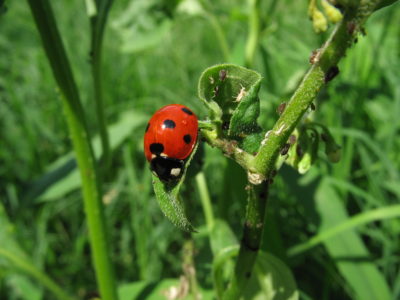|
Listen To The Article
|
 Ladybugs, also known as lady beetles or ladybirds, are a favorite of many insect enthusiasts and the rest of us. Their petite, circular bodies with cheerful black-on-red polka dots make this bug downright cute. Perhaps it was the appearance of ladybugs that inspired so many myths and children’s rhymes. The popular nursery rhyme, Ladybird, Ladybird, has its counterpart in the German language and similar poems throughout the world. They are also considered to be lucky in many of the world’s cultures. In Turkey, ladybugs are called good luck bugs. In many places, including the U.S, seeing a ladybug or releasing one is an indicator that a wish will come true.
Ladybugs, also known as lady beetles or ladybirds, are a favorite of many insect enthusiasts and the rest of us. Their petite, circular bodies with cheerful black-on-red polka dots make this bug downright cute. Perhaps it was the appearance of ladybugs that inspired so many myths and children’s rhymes. The popular nursery rhyme, Ladybird, Ladybird, has its counterpart in the German language and similar poems throughout the world. They are also considered to be lucky in many of the world’s cultures. In Turkey, ladybugs are called good luck bugs. In many places, including the U.S, seeing a ladybug or releasing one is an indicator that a wish will come true.
These adorable little beetles are clearly enjoyed by many, for several reasons that are historical and folkloric. For practical reasons, gardeners and farmers love ladybugs. They are voracious predators of other insects, especially the destructive aphids. On the other hand, ladybugs can swarm and infest homes, which can make them a pest in their own right.
Coccinellidae
Ladybugs belong to a family of beetles called Coccinellidae. All of the species in this family are small, round beetles with varying color patterns. Most, however, are red, orange, or yellow with black spots. The colored portions of their bodies are the covers for their wings, and they also have black legs, heads, and antennae. There are over 5,000 species of Coccinellidae throughout the world and nearly 500 in North America. You might see some that are mostly black because the spots are so large they merge. Otherwise, there is not a huge amount of variety in the appearance of these different ladybug species.
Discover Amazing Butterflies, Moths, Spiders, Dragonflies, and Other Insects!
The bright color of ladybugs is a strategy for avoiding predation. They are able to secrete a foul tasting substance so that the predator learns not to try the bright, little beetles again. In spite of this technique, ladybugs still find themselves the victims of birds, spiders, frogs, and dragonflies. You will mostly find ladybugs in your yard or garden, on or around the plants on which their food is located. They lay eggs on the leaves of these plants so that their larvae will have the best possible chance of finding prey after hatching.
Ladybugs As Predators
The best reason to be pleased to see ladybugs on your property is that they act as a natural and organic type of pest control. The larvae that hatch from their eggs feed voraciously as they grow up to adult beetles, and one ladybug will eat around 5,000 prey insects in its lifetime. Your neighborhood ladybugs largely feed on aphids, although they may also eat hemlock wooly adelgid or scale insects.
Ladybugs are so useful at destroying infestations of aphids that the U.S. Department of Agriculture actually released populations of the Asian ladybug in the late ‘70s and early ‘80s. The project was an attempt to increase ladybug populations in the eastern U.S., specifically to target and destroy aphids.
Aphids
If you are a long time and avid gardener, you do not need to be told about aphids. If you are new to growing plants, you may have seen aphids without realizing what they are. Aphids are also called plant lice in some places or greenflies, blackflies, or whiteflies. (They should not be confused, however, with true whiteflies.) They are very small insects that feed on the sap of plants and are more destructive to gardens in temperate climates than nearly any other insect. There are around 4,000 species of aphids in the world, but only about 250 are pests and enemies of farmers and gardeners.
You will see these little pests on the leaves of your plants. They are about one-tenth of an inch long and may be green, black, brown, gray, or reddish-brown, with the first two being most common. Aphids lay eggs on the leaves of your plants in the fall. They overwinter and hatch as nymphs in the spring. The nymphs can then reproduce asexually, a feature that had made this pest so pestilent.
The best way to determine if you have an aphid infestation is by looking for the bugs on the leaves of your plants. They will also leave telltale signs of their presence. Aphids suck the sap out of your plants using their mouths, which look like beaks. They also inject their saliva into the plant while feeding. This can result in the spread of disease from one plant to another. The loss of sap will cause the plant to weaken and wilt and may delay the production of flowers and fruit or stunt the growth of the plant. The aphids leave behind a clear and sticky substance called honeydew. This can turn into sooty mold, which is very destructive to the plant.
Getting Ladybugs In Your Garden
Aphids are a bane to your garden and there are plenty of chemical pesticides available that are designed to attack and kill these little guys. There are also pesticides based on microbes that have proven successful in killing aphids. For minor infestations, sometimes a good spraying of the plant with a hose will knock them off and solve the problem in the short term.
A great, natural way to eliminate your aphid problem is to increase your property’s ladybug population. One ladybug will eat nearly fifty aphids in a single day. Even if you do not have an aphid problem, keeping a healthy population of ladybugs around is a good idea as a preventative measure.
You may be able to find live ladybugs for sale at your local gardening center or nursery, but if not, you will find numerous online stores that will sell and ship you a batch of ladybugs. You can release them immediately, or keep them inside in a terrarium for a small amount of time first. To feed them, you can find leaves with aphids, or give them raisins that have been softened in water. The bugs will be able to survive on the raisins for a short period of time, but will eventually need some aphids.
Some people would suggest that buying ladybugs is not necessarily useful or ecologically responsible. You may be purchasing a species that is not native to your area and you risk them taking over for the local bugs. Also, the effectiveness of releasing bugs in your yard is doubtful to some. The ladybugs may simply fly away and find another place to settle. However, the cost of a batch of bugs is not very great, so it may be worth it to try.
As an alternative to purchasing them, you might consider populating your garden with plants that will attract your native ladybugs. They like fennel, yarrow, dill, butterfly weed, tansy, hairy vetch, Queen Anne’s lace, prairie sunflower, coriander, and carpet bugleweed among other flowering plants. They use these plants as resting spots and also as a secondary food source.
Ladybugs As Pests
In some instances, ladybugs themselves can be pests. This is not too common, however, and their positive attributes far outweigh the occasional negatives. The Asian species of ladybug that was introduced by the Department of Agriculture can occasionally infest homes. In the fall, they need a warm place to hibernate, and houses are often a perfect place. They tend to infest homes that have a lot of trees around them and that are light-colored. They also prefer to be near light, so they congregate on the sunny side of buildings. To make matters worse, these beetles secrete a pheromone when they find a good spot. The scent given off is a signal to other individuals that they found a good spot and that everyone should join them.
In the spring, as it warms up outside, the ladybugs will emerge from the house and leave it behind to feed, mate and live in the outdoors once again. The best way to cope with this infestation is to prevent it from happening in the first place. Be sure that your doors, windows, and vents are well sealed from the outside so that the bugs cannot gain entry. When you do have them indoors, get rid of them by vacuuming or sweeping rather than by using a pesticide. Other than being a mild nuisance, ladybug infestations are not harmful. They are not known to carry disease, have no interest in your food, do not bite, and are not poisonous.
 Off The Grid News Better Ideas For Off The Grid Living
Off The Grid News Better Ideas For Off The Grid Living




